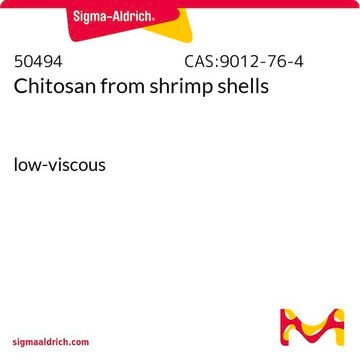The degree of acetylation should be above 75% for each lot, but the exact value will vary. For information on the degree of acetylation for a particular lot, contact the local technical service team.
48165
Chitosan from crab shells
highly viscous
Sinonimo/i:
2-Amino-2-deoxy-(1→4)-β-D-glucopyranan, Poly-(1,4-β-D-glucopyranosamine)
About This Item
Prodotti consigliati
Origine biologica
(crab)
Stato
powder
Impurezze
≤1% insoluble matter
Residuo alla calcinazione
≤2% (as SO4)
Perdita
≤12% loss on drying
Colore
yellow
Viscosità
>400 mPa.s, 1 % in acetic acid(20 °C)
InChI
1S/C56H103N9O39/c1-87-56(86)65-28-38(84)46(19(10-74)96-55(28)104-45-18(9-73)95-49(27(64)37(45)83)97-39-12(3-67)88-47(85)20(57)31(39)77)103-54-26(63)36(82)44(17(8-72)94-54)102-53-25(62)35(81)43(16(7-71)93-53)101-52-24(61)34(80)42(15(6-70)92-52)100-51-23(60)33(79)41(14(5-69)91-51)99-50-22(59)32(78)40(13(4-68)90-50)98-48-21(58)30(76)29(75)11(2-66)89-48/h11-55,66-85H,2-10,57-64H2,1H3,(H,65,86)/t11-,12-,13-,14-,15-,16-,17-,18-,19-,20-,21-,22-,23-,24-,25-,26-,27-,28-,29-,30-,31-,32-,33-,34-,35-,36-,37-,38-,39-,40-,41-,42-,43-,44-,45-,46-,47-,48+,49+,50+,51+,52+,53+,54+,55+/m1/s1
FLASNYPZGWUPSU-SICDJOISSA-N
Cerchi prodotti simili? Visita Guida al confronto tra prodotti
Descrizione generale
Applicazioni
Altre note
Codice della classe di stoccaggio
11 - Combustible Solids
Classe di pericolosità dell'acqua (WGK)
nwg
Punto d’infiammabilità (°F)
Not applicable
Punto d’infiammabilità (°C)
Not applicable
Dispositivi di protezione individuale
Eyeshields, Gloves, type N95 (US)
Scegli una delle versioni più recenti:
Possiedi già questo prodotto?
I documenti relativi ai prodotti acquistati recentemente sono disponibili nell’Archivio dei documenti.
-
What is the degree of deacetylation of this reagent?
1 risposta-
Utile?
-
-
What is the molecular weight of this chitosan (ref 48165)?
1 risposta-
The molecular weight for this product is not analyzed on a lot to lot basis. However, the expected range is 500,000 to 700,000 g/mol.
Utile?
-
-
Greetings I wish to know if this chitosan is soluble or insoluble in water. I also realized that there is water-soluble chitosan. Please kindly clarify the difference. I need them to do laboratory experiments.
1 risposta-
This product has not been tested for it's solubility in water. However, one gram chitosan can be dissolved in a mixture of 100mL 10% acetic acid and 50mL methanol, and then precipitated from a precipitant consisted of 10mL ethanol and 90mL acetate ester. The treated chitosan should become soluble in acid-free water completely at 8.02mg/mL
Utile?
-
Filtri attivi
Il team dei nostri ricercatori vanta grande esperienza in tutte le aree della ricerca quali Life Science, scienza dei materiali, sintesi chimica, cromatografia, discipline analitiche, ecc..
Contatta l'Assistenza Tecnica.



